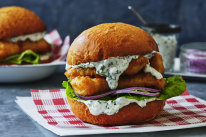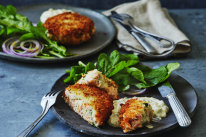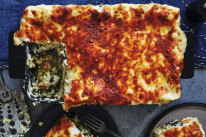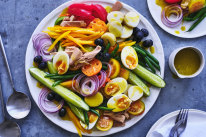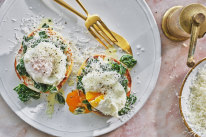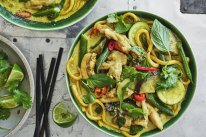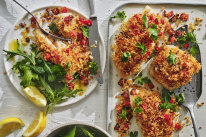‘Hold your nerve’: Adam Liaw’s classic creme caramel is an important lesson in cooking chemistry
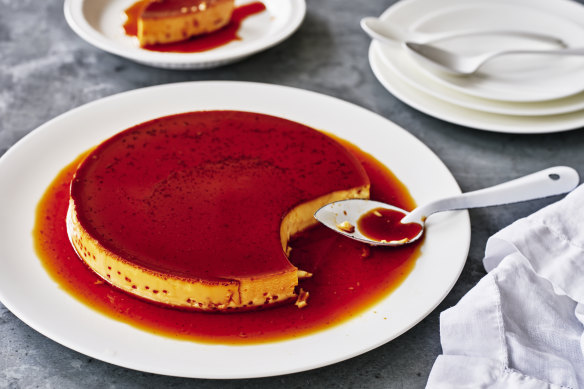
The classic creme caramel is made of just four ingredients, but this dessert is only possible because of some of the most important cooking chemistry you will ever need to know.
Creme caramel is a near-perfect dessert, and understanding the science of two of the most common ingredients in cooking – sugar and eggs – can be the difference between success and failure (see tips).
Ingredients
100g caster sugar, plus 150g for the caramel
A little vegetable oil
1 vanilla bean, seeds scraped, or 1 tsp vanilla extract
600ml milk
4 eggs, plus 2 egg yolks
Method
Step 1
Place the 150g of sugar into a small saucepan with a tablespoon or two of water. Swirl the pan to wet all the sugar. Place the saucepan over high heat and bring to a boil. Heat the sugar to a dark caramel, swirling occasionally instead of stirring. Once dark, remove from the heat and pour the caramel into a 1.4-litre-capacity baking dish (about 20cm round x 5cm high), swirling the dish to coat. Rub a little vegetable oil around the outside of the dish above the caramel.
Step 2
Heat the oven to 140C fan-forced (160C conventional). Place the milk and vanilla in a medium saucepan and bring to a simmer, making sure it doesn’t boil over. Combine the remaining 100g of sugar with the eggs and egg yolks. Stir with a whisk until the sugar and eggs are completely combined and the sugar has dissolved. Slowly pour the warm milk into the egg and sugar mixture and stir to combine. Strain through a fine sieve into the baking dish, and if you like, flash a blowtorch across the top to burst any air bubbles.
Step 3
Place the baking dish into a deep roasting dish large enough to hold the first dish completely. Place the roasting dish onto the oven shelf and pour enough boiling water into the roasting dish so that it comes halfway up the sides of the baking dish. Bake for 45-60 minutes, testing after 45 minutes by tapping the side of the baking dish to form a ripple in the custard. When the custard is nearly set, the ripple will be very small and right at the centre of the dish. Remove the roasting dish and custard from the oven and allow both to cool to room temperature. Removing the custard from the water bath, cover with a serving plate and transfer to the fridge to chill for at least 4 hours but preferably 8 or more.
Step 4
To invert the creme caramel, use your fingers to pull the custard away from the edge of the dish (or run a knife around the edge if it is not releasing), then invert it onto a serving plate.
Tips
Sugar
The magic of heating sugar gives us some of the most impressive sweet creations possible. The chemistry of what happens at each stage is all-important.
Mix sugar with a little water and apply heat. As it heats, it will move through the following stages:
- Thread (110-112C, for jams and syrups),
- Soft ball (112-116C, for fudge, soft sweets),
- Firm ball (116-121C, for fondant, soft caramels),
- Hard ball (121-130C, for Italian meringue, marshmallow),
- Soft crack (131-143C, for taffy and firm butterscotch),
- Hard crack (145-154C, for nut brittles, hard candies).
As the sugar cooks through these stages, it loses water – from about 20 per cent water at the thread stage, to about 1 per cent water at the hard-crack stage. The difference in water content determines how the sugar behaves in each of the sweets mentioned.
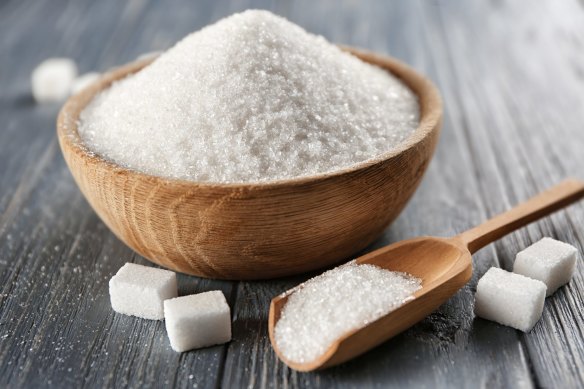
Beyond 155C, the water is all gone and the sugar starts to caramelise. This process creates thousands of different colour and flavour molecules that turn the sugar from simply sweet, to the complex buttery, toffee and bitter notes that distinguish a dark caramel.
A light caramel at around 160C will be pale golden in colour, mild in flavour and still quite sweet, but for creme caramel I like the caramel to reach about 185C, at which point it will be very dark brown and have a bitter and complex flavour profile to balance the sweet custard. If you want a great creme caramel, hold your nerve and get your caramel as dark as you dare. It will give the dish greater complexity.
Take care, however, as beyond 185C the sugar will start to blacken and become very bitter to the point of unpleasantness.
Eggs
The extraordinary chemistry of eggs has made them the most versatile ingredient in cooking. The yolk is slightly acidic and the white alkaline. Both contain proteins that bond at different temperatures (and contrary to popular belief, the yolk is actually richer in protein than the white). Even these two facts reveal a lot about how eggs are used.
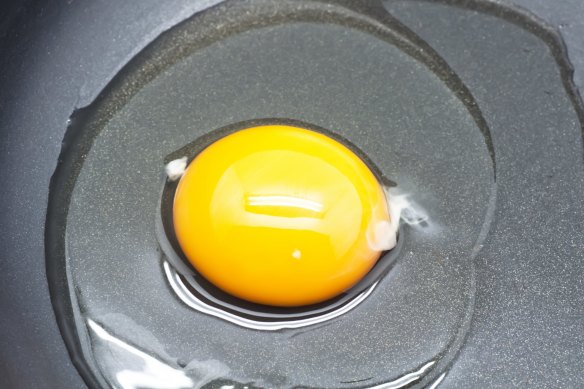
We add eggs to meatballs and meatloaf to help them bind (the proteins in meat bind well enough on their own, but when you add breadcrumbs or vegetables to the mix, you need the extra protein from an egg to bind the mixture). Egg whites are added to Chinese marinades because their alkalinity tenderises the meat by inhibiting protein bonding (it is alkaline substances, not acids, that help tenderise meat for cooking).
In a custard or creme caramel, we’re mainly looking for the proteins in the yolk rather than the white, as these are the ones that gel and hold moisture to give us a soft and silky custard. This is why the recipe uses extra yolks instead of whole eggs. These proteins will gel at about 82C, but you want that process to happen slowly, and with other things in the mix as well.
Heat an egg yolk quickly to 82C and the proteins will quickly bond to each other and form a firm mass, like the centre of a hard-boiled egg. Add milk and sugar, and they will slow the protein-bonding process, resulting in a softer, more silky custard. Slowing the process even more is where the bain marie comes in.
Bain marie
Literally meaning “Mary’s bath”, a bain marie is a bath of water used to slow and even out heat transfer during cooking. It can vary in form from being a bowl placed over boiling water (for melting chocolate or whisking eggs) to the roasting dish of water our baking dish is placed in.
In cooking, water is the only ingredient more versatile and more important than eggs and sugar. And the fact that water boils at 100C is one of the most useful scientific facts.
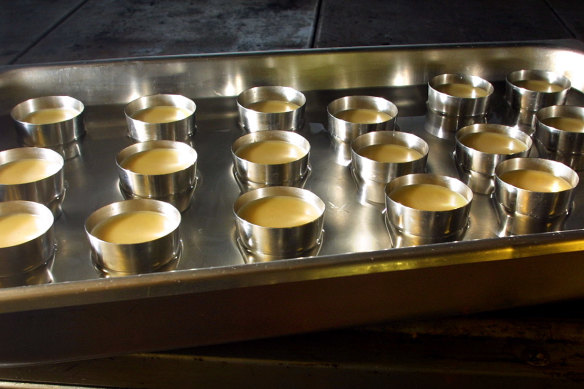
Without a bain marie, an oven set at 140C would conduct heat through the baking dish, cooking the outside of the creme caramel much faster than the centre, leaving it tough and grainy. But surrounding the dish with water, which cannot get hotter than 100C, insulates the custard and slows down the cooking process, leading to a silkier result.
You might ask why we don’t just set the oven to the setting temperature of the custard (82C). Well, you could, it would just be very slow. I’ll sometimes cook creme caramel at 90C, and while the results are excellent, it takes about 4 hours to set.
Appears in these collections
- 40 fantastique French recipes for the Paris Olympics (and beyond)
- 30+ retro desserts to revisit (starring this enduring budget-friendly family favourite)
- Simply the zest: The 25 most popular cakes and bakes of 2023
- From chicken curry to apple cake: The 20 most popular recipes of April 2023
- From Aussie bolognese to quick chicken curry: Adam Liaw’s 10 dishes you need to master
The best recipes from Australia's leading chefs straight to your inbox.
Sign upFrom our partners
Similar Recipes

Adam Liaw’s step-by-step guide to making the perfect chicken parmigiana at home
- 30 mins - 1 hr
- Adam Liaw

